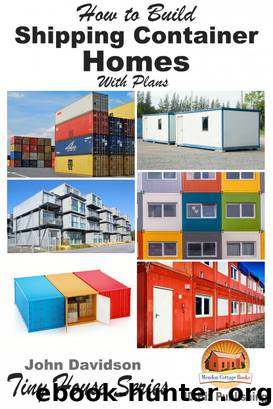How to Build Shipping Container Homes With Plans by John Davidson

Author:John Davidson
Language: eng
Format: epub
Tags: how to build, container, shipping container, container homes, container homes with plans, how to build shipping container homes with plans
Publisher: Mendon Cottage Books
40’ Container design
Chapter Five
Advanced Framing
Advanced Framing or Optimum Value Engineering (OVE) uses a number of techniques to reduce the consumption of lumber and waste produced in building construction. Some of the techniques used in Advanced Framing include:
1. Spacing of wall studs (2x6) at 24” on center instead of the traditional 16” on center spacing
2. Spacing of floor joists and roof rafters at 24” on center
3. Not using headers in non-load bearing walls
4. Use single lumber headers and top plates at appropriate places
5. Eliminating cripples and double studs around windows and doors
When you frame the walls, make allowances of few inches for adding insulation and sheathing between the closed door and the framings. You will require bolts and a drill bit to drill the bolts through the container and the frames. Galvanized bolts and washer must be used at places that are exposed to external surroundings; you can use regular bolts for internal purposes. If you are building a container home with multiple rooms, you must frame the internal walls before proceeding to the sheathing and insulation.
Once the framing is in place, the next step is to sheath your container. You can use regular OSB boards for sheathing purposes. Following are the sheathing wraps to consider for your container home:
a. Asphalt felt or tar paper – are excellent water resistant materials and has high permeability when wet; the disadvantage is that it will tear easily and deteriorate under UV exposure. This can be used both as a sheathing wrap and as a roofing underlayment
b. Grade-D building paper – this is usually used under stucco and deteriorates if saturated with water
c. Synthetic house wrap – this is used as a sheathing wrap under siding and has good permeability. Perforated variety of this house wrap has low resistance to water and is generally used in dry areas; the non-perforated variety has high resistance to water and can be used as air-infiltration barrier (if taped) at all the edges and seams
d. Draining house wrap – this too is used as a sheathing wrap under siding and acts as a moderate rain screen
The main purpose of using a sheathing wrap is to protect the house against water leakage. Therefore, it is important to cover the roof, gable ends, and walls with a sheathing wrap. It is also advisable to flash the window and door with a sheathing wrap; using a caulking material or a sealant will not protect your container house from weathering effects in the long run. Investing in a sheathing wrap is one aspect where you must not cut corners. This will not only act as a protective barrier but will also increase the longevity of your house. According to the building code, if you are using a plastic house wrap, you must wrap the corners at least 6” each way.
The next step after sheathing is to install your windows and doors. It is advisable to pre-order your doors and windows before beginning your framing work. You can opt for traditional style doors
Download
This site does not store any files on its server. We only index and link to content provided by other sites. Please contact the content providers to delete copyright contents if any and email us, we'll remove relevant links or contents immediately.
Kathy Andrews Collection by Kathy Andrews(11767)
The remains of the day by Kazuo Ishiguro(8896)
Spare by Prince Harry The Duke of Sussex(5142)
Paper Towns by Green John(5141)
The Body: A Guide for Occupants by Bill Bryson(5033)
Industrial Automation from Scratch: A hands-on guide to using sensors, actuators, PLCs, HMIs, and SCADA to automate industrial processes by Olushola Akande(5027)
Machine Learning at Scale with H2O by Gregory Keys | David Whiting(4262)
Be in a Treehouse by Pete Nelson(3999)
Never by Ken Follett(3885)
Harry Potter and the Goblet Of Fire by J.K. Rowling(3810)
Goodbye Paradise(3767)
Into Thin Air by Jon Krakauer(3350)
The Remains of the Day by Kazuo Ishiguro(3348)
Fairy Tale by Stephen King(3310)
The Cellar by Natasha Preston(3299)
The Genius of Japanese Carpentry by Azby Brown(3256)
120 Days of Sodom by Marquis de Sade(3229)
The Man Who Died Twice by Richard Osman(3042)
Drawing Shortcuts: Developing Quick Drawing Skills Using Today's Technology by Leggitt Jim(3040)
